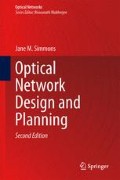Abstract
An optical network is composed of the fiber-optic cables that carry channels of light, combined with the equipment deployed along the fiber to process the light. There has been a gradual migration from an architecture where the optical network served simply as a collection of static pipes to one where it is viewed as another networking layer. In the optical networking paradigm, functions such as routing and protection are supported at the granularity of a wavelength, which can be operationally very advantageous. One of the most transformative innovations has been the advent of optical bypass technology, which allows a signal to remain in the optical domain for all, or much, of its path from source to destination. Maintaining signals in the optical domain allows a significant amount of equipment to be removed from the network and provides a scalable trajectory for network growth. This chapter presents a brief history of optical networking and an overview of its current state. Additionally, it discusses relevant research trends, to provide insight into future optical networking advancements.
Access this chapter
Tax calculation will be finalised at checkout
Purchases are for personal use only
Notes
- 1.
The term “wavelength” is commonly used in two different contexts: first, it refers to a channel of light; second, it refers to the specific point in the spectrum of light where the channel is centered (e.g., 1,550 nanometers). The context should be clear from its usage; however, when necessary, clarifying text is provided.
- 2.
Regeneration is performed to restore the quality of the signal.
- 3.
Other common names for this tier are the long-haul network or the core network. These terms are used interchangeably throughout the book.
- 4.
The ITU recommendations discussed in this book have been developed by the Telecommunication Standardization Sector of the ITU, also known as ITU-T.
- 5.
Office refers to a building that houses major pieces of telecommunications equipment, such as switches and client equipment.
- 6.
The loss increases with fiber distance and the number of fiber connectors; thus, these various types of interfaces determine the allowable interconnection arrangements within an office.
References
[ABGL01] D. Awduche, L. Berger, D. Gan, T. Li, V. Srinivasan, G. Swallow, RSVP-TE: Extensions to RSVP for LSP tunnels, Internet Engineering Task Force, Request for Comments (RFC) 3209, (December 2001)
[AbMA09] S. Abdallah, M. Maier, C. Assi (ed.), Broadband Access Networks: Technologies and Deployments, (Springer, New York, 2009)
[BBFL10] M. Bocci, S. Bryant, D. Frost, L. Levrau, L. Berger, A framework for MPLS in transport networks, draft-ietf-mpls-tp-framework-12, Internet Engineering Task Force, Work In Progress, (May 2010)
[BeRS03] G. Bernstein, B. Rajagopalan, D. Saha, Optical Network Control: Architecture, Protocols, and Standards, (Addison-Wesley Professional, Reading, 2003)
[ChSc07] M. W. Chbat, H.-J. Schmidtke, Falling boundaries from metro to ULH optical transport equipment. Proceedings, Optical Fiber Communication/National Fiber Optic Engineers conference (OFC/NFOEC’07), Paper NTuA3. Anaheim, 25–29 March 2007
[Gora02] W. J. Goralski, SONET/SDH, 3rd edn. (McGraw-Hill, New York, 2002)
[Gril12] E. Griliches, Ciena wavelogic 3 Technology: “Moving the goal posts”, ACG Research Technology Impact, (March 2012)
[IEEE09] IEEE, Provider Backbone Bridge Traffic Engineering, IEEE Std 802.1Qay™, (August 2009)
[ITU01] International Telecommunication Union, Architecture of Optical Transport Networks, ITU-T Rec. G.872, (November 2001)
[ITU11] International Telecommunication Union, Architecture of the Multi-Protocol Label Switching Transport Profile layer network, ITU-T Rec. G.8110.1/Y.1370.1, (December 2011)
[ITU12a] International Telecommunication Union, Interfaces for the Optical Transport Network (OTN), ITU-T Rec. G.709/Y.1331, (February 2012)
[ITU12c] International Telecommunication Union, Architecture for the Automatically Switched Optical Network (ASON), ITU-T Rec. G.8080/Y.1304, (February 2012)
[KaKY03] D. Katz, K. Kompella, D. Yeung, Traffic engineering (TE) extensions to OSPF version 2, Internet Engineering Task Force, Request for Comments (RFC) 3630, (September 2003)
[Lam07] C. Lam (ed.), Passive Optical Networks: Principles and Practice, (Academic Press, Burlington, 2007)
[Lin06] C. Lin (ed.), Broadband Optical Access Networks and Fiber-to-the-Home: Systems T echnologies and Deployment Strategies, (Wiley, West Sussex, 2006)
[Mann04] E. Mannie (ed.), Generalized Multi-Protocol Label Switching (GMPLS) architecture, Internet Engineering Task Force, Request for Comments (RFC) 3945, (October 2004)
[Mukh06] B. Mukherjee, Optical WDM Networks, (Springer, New York, 2006)
[NBBS09] B. Niven-Jenkins, D. Brungard, M. Betts, N. Sprecher, S. Ueno, Requirements of an MPLS Transport Profile, Internet Engineering Task Force, Request for Comments (RFC) 5654, (September 2009)
[OIF04] Optical Internetworking Forum, User Network Interface (UNI) 1.0 Signaling Specification, Release 2, 27 February 2004
[RaSS09] R. Ramaswami, K. N. Sivarajan, G. Sasaki, Optical Networks: A Practical Perspective, 3rd edn. (Morgan Kaufmann Publishers, San Francisco, 2009)
[Sale98b] A. A. M. Saleh, Short- and long-term options for broadband access to homes and businesses, Conference on the Internet: Next Generation and Beyond, Cambridge, 1–2 November 1998.
[Sale06] A. A. M. Saleh, Program Manager, Dynamic multi-terabit core optical networks: Architecture, protocols, control and management (CORONET), Defense Advanced Research Projects Agency (DARPA) Strategic Technology Office (STO), BAA 06-29, Proposer Information Pamphlet (PIP), August 2006
[SDIR05] G. Swallow, J. Drake, H. Ishimatsu, Y. Rekhter, Generalized Multiprotocol Label Switching (GMPLS) User-Network Interface (UNI): Resource ReserVation Protocol-Traffic Engineering (RSVP-TE) support for the overlay model, Internet Engineering Task Force, Request for Comments (RFC) 4208, (October 2005)
[StEB08] T. E. Stern, G. Ellinas, K. Bala, Multiwavelength Optical Networks: Architectures, Design, and Control, 2nd edn. (Cambridge University Press, Cambridge, 2008)
[Tekt01] Tektronix, SONET telecommunications standard primer, (August 2001), www.tek.com/document/primer/sonet-telecommunications-standard-primer. Accessed 20 Mar 2014
[Telc09] Telcordia Technologies, Synchronous Optical Network (SONET) transport systems: Common generic criteria, GR–253–CORE, Issue 5, October 2009
[WASG96] R. E. Wagner, R. C. Alferness, A. A. M. Saleh, M.S. Goodman, MONET: Multiwavelength optical networking. J. Lightwave Technol. 14(6), 1349–1355, (June 1996)
Author information
Authors and Affiliations
Corresponding author
Rights and permissions
Copyright information
© 2014 Springer International Publishing Switzerland
About this chapter
Cite this chapter
Simmons, J. (2014). Introduction to Optical Networks. In: Optical Network Design and Planning. Optical Networks. Springer, Cham. https://doi.org/10.1007/978-3-319-05227-4_1
Download citation
DOI: https://doi.org/10.1007/978-3-319-05227-4_1
Published:
Publisher Name: Springer, Cham
Print ISBN: 978-3-319-05226-7
Online ISBN: 978-3-319-05227-4
eBook Packages: EngineeringEngineering (R0)

